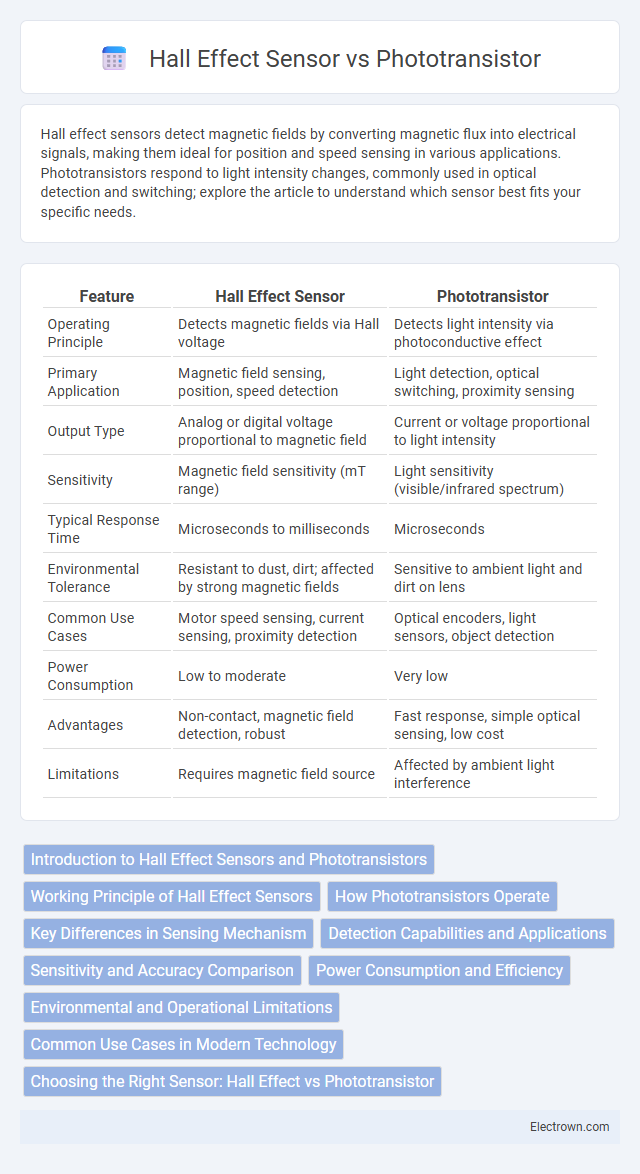Hall effect sensors detect magnetic fields by converting magnetic flux into electrical signals, making them ideal for position and speed sensing in various applications. Phototransistors respond to light intensity changes, commonly used in optical detection and switching; explore the article to understand which sensor best fits your specific needs.
Table of Comparison
| Feature | Hall Effect Sensor | Phototransistor |
|---|---|---|
| Operating Principle | Detects magnetic fields via Hall voltage | Detects light intensity via photoconductive effect |
| Primary Application | Magnetic field sensing, position, speed detection | Light detection, optical switching, proximity sensing |
| Output Type | Analog or digital voltage proportional to magnetic field | Current or voltage proportional to light intensity |
| Sensitivity | Magnetic field sensitivity (mT range) | Light sensitivity (visible/infrared spectrum) |
| Typical Response Time | Microseconds to milliseconds | Microseconds |
| Environmental Tolerance | Resistant to dust, dirt; affected by strong magnetic fields | Sensitive to ambient light and dirt on lens |
| Common Use Cases | Motor speed sensing, current sensing, proximity detection | Optical encoders, light sensors, object detection |
| Power Consumption | Low to moderate | Very low |
| Advantages | Non-contact, magnetic field detection, robust | Fast response, simple optical sensing, low cost |
| Limitations | Requires magnetic field source | Affected by ambient light interference |
Introduction to Hall Effect Sensors and Phototransistors
Hall effect sensors detect magnetic fields using the Hall effect principle, converting magnetic flux into an electrical signal, making them vital in position and speed sensing applications. Phototransistors respond to light intensity by varying current flow in response to photons, widely used in optical detection and switching circuits. Your choice between these sensors depends on whether magnetic or optical detection suits your application's environmental and functional requirements.
Working Principle of Hall Effect Sensors
Hall effect sensors operate based on the Hall effect, where a voltage is generated perpendicular to an electric current flowing through a conductor in the presence of a magnetic field. This voltage is proportional to the strength of the magnetic field, enabling precise detection of magnetic presence and position. Unlike phototransistors, which rely on light intensity to function, Hall effect sensors are ideal for non-contact magnetic sensing applications.
How Phototransistors Operate
Phototransistors operate by converting light into electrical current, utilizing the photoconductive properties of semiconductor materials to amplify the photocurrent generated when exposed to light. Unlike Hall effect sensors that detect magnetic fields, phototransistors respond directly to visible or infrared light, making them ideal for optical sensing applications. Their sensitivity and fast response time enable precise detection of light intensity changes in electronic devices and automation systems.
Key Differences in Sensing Mechanism
Hall effect sensors detect magnetic fields by measuring voltage changes generated when charged particles move through a conductor in a magnetic field, enabling precise magnetic flux detection. Phototransistors sense light intensity by converting photons into electrical current via semiconductor junctions, allowing them to respond to visible or infrared light. The fundamental difference lies in Hall effect sensors responding to magnetic stimuli, whereas phototransistors are activated by optical signals.
Detection Capabilities and Applications
Hall effect sensors detect magnetic fields with high precision, making them ideal for rotational speed measurement, current sensing, and proximity detection in automotive and industrial applications. Phototransistors respond to light intensity changes, offering fast and sensitive optical detection used in remote controls, light meters, and object detection systems. Your choice depends on whether magnetic field detection or optical sensing best suits your application's requirements.
Sensitivity and Accuracy Comparison
Hall effect sensors provide precise magnetic field measurements with high linearity, making them highly sensitive and accurate for detecting magnetic variations. Phototransistors offer sensitivity primarily to light intensity changes but may experience slower response times and lower accuracy due to ambient light interference. Choosing between the two depends on your application's need for magnetic accuracy versus optical sensitivity, with Hall effect sensors excelling in precise magnetic detection.
Power Consumption and Efficiency
Hall effect sensors typically exhibit lower power consumption compared to phototransistors due to their magnetic field-based detection, which requires minimal current to operate. Phototransistors often demand higher power to maintain their light-sensitive operation, especially in applications needing continuous illumination or rapid switching. Efficiency in Hall effect sensors is enhanced by their ability to function reliably under varying environmental conditions without additional power-intensive components, whereas phototransistors may require supplementary circuitry for stable performance.
Environmental and Operational Limitations
Hall effect sensors exhibit strong resistance to environmental factors such as dust, moisture, and light interference, making them highly reliable in harsh and variable conditions. Phototransistors, however, are sensitive to ambient light levels and can be affected by temperature variations, which may cause signal fluctuations and reduced accuracy. Operationally, Hall effect sensors perform better in electromagnetic noisy environments due to their magnetic field detection principle, whereas phototransistors require careful shielding to maintain consistent performance.
Common Use Cases in Modern Technology
Hall effect sensors are commonly used in automotive applications for detecting wheel speed, position sensing in brushless motors, and current sensing in power management systems. Phototransistors are frequently employed in optical switches, ambient light detection, and remote control receivers for consumer electronics. Your choice between the two will depend on whether your application requires magnetic field detection or optical signal sensing.
Choosing the Right Sensor: Hall Effect vs Phototransistor
Choosing the right sensor depends on your application's requirements for magnetic field detection or light sensing. Hall effect sensors provide accurate and contactless measurements of magnetic fields, ideal for position and speed detection, while phototransistors excel in detecting light intensity and are well-suited for optical switches and ambient light sensing. Evaluate your project's need for magnetic responsiveness versus light sensitivity to ensure your sensor choice delivers optimal performance and reliability.
Hall effect sensor vs phototransistor Infographic

 electrown.com
electrown.com